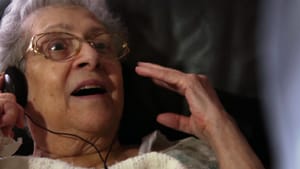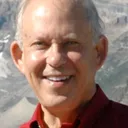Stay in the Loop
BSR publishes on a weekly schedule, with an email newsletter every Wednesday and Thursday morning. There’s no paywall, and subscribing is always free.
What happens when we find out that the most compromised among us are “alive inside”?
Michael Rossato-Bennett's 'Alive Inside'

Alive Inside is a new and attention-getting documentary film that demonstrates the power of music in bringing life back to dementia patients who otherwise would be sitting alone, mute, and inactive in nursing homes and other facilities waiting for the end to come. Dan Cohen, an inventive social worker with a background in technology and knowledge of brain science, found in many cases that if he played music that related to a patient’s history, he or she would become active, respond physically and emotionally to the rhythm, experience a resurgence of memories, and relate warmly with others. In other words, patients would come out of their shells.
This is comparable to the situation in the book and film Awakenings by Oliver Sacks, in which patients who had been asleep for several decades woke up for a period of time after being given a Parkinson’s drug. Neurologist Sacks appears briefly in Alive Inside to explain how music has centers throughout the brain that are less damaged by dementia than the cognitive centers. The film is very absorbing and moving, using the deceptively simple device of following several patients who responded with joy and a sense of revelation to listening to once-familiar music played on iPods through headphones.
Can headphones really replace medication?
The film thus makes — indeed, overly insists upon — the questionable point that simple technology like iPods and headphones could replace or supplement medications, initiating a revolution in care of the elderly. A medical doctor develops the important idea that health care is “hooked” on medication and could benefit from more humanistic forms of treatment.
That is undoubtedly true, but medication is very important in treating dementia, and there are many ways to humanize patient care beyond the use of music. Touch, movement (dance, etc.), visual stimulation, cognitive tasks, and simple human contact all activate the nervous system and have therapeutic value. What really needs to be changed on a large scale is the attitude of regarding elderly patients as beyond help, dehumanizing the way we treat old people in our culture.
That said, the film's merit is not only its deep compassion but also the fact that it makes us think about many vital issues.
The mysteries and music of the brain
 Most immediately, the film awakens us to the fascinating workings of our brains. Most of us think, as did philosophers like Descartes, of the brain as a “thinking machine,” a biological calculator or computer created by nature to solve problems. But the brain does a lot of other things. It determines sleep and wakefulness, regulates our emotions and metabolism, creates images in the form of dreams and fantasies, stores memories, gives us our sensory “picture” of the world, and — lo and behold — translates sound and rhythm into music.
Most immediately, the film awakens us to the fascinating workings of our brains. Most of us think, as did philosophers like Descartes, of the brain as a “thinking machine,” a biological calculator or computer created by nature to solve problems. But the brain does a lot of other things. It determines sleep and wakefulness, regulates our emotions and metabolism, creates images in the form of dreams and fantasies, stores memories, gives us our sensory “picture” of the world, and — lo and behold — translates sound and rhythm into music.
What possible purpose could music serve other than as a form of entertainment? Why would so many of the brain’s resources be devoted to such a pastime? It’s a bit like saying the brain evolved so we can watch baseball games. But if we go deeper, we begin to see that music is really part of the life-saving communication process going back to bird calls, dolphin sounds, and the screams and yelps of animals in the wild.
In humans, communication becomes part of culture, which includes rituals of initiation, celebration, and mourning, in which music plays an important role. Music helps regulate our emotions and interpersonal relations on a tribal, group level. The brain has learned through evolution how important that is to the survival of our species. When we see the patients in the film respond to music at a deep emotional level, we become aware of how important music is to our lives and well-being. The next time you meet a musician, thank him or her!
How do we relate to rock-bottom diseases and conditions?
Very profoundly, the movie brings us face-to-face with a difficult problem: How do we relate to the “hopeless cases” in our lives — both individually and as a society? Whether it’s a person with terminal cancer or advanced Alzheimer’s disease, a quadriplegic, a homeless person, a man on death row, a severely mentally impaired individual, what is our attitude, what are our feelings, what do we as individuals and society do?
On the positive side, we have compassion, probably more than most societies. On the negative side, we distance ourselves from these "unfortunates." We put them in facilities, we label them, we leave them alone, we make them into medical cases, and we soothe ourselves by thinking we are not like them. Of course there are wonderful exceptions which warm all of our hearts, but we are a society of the young, the healthy, the competitive, and the powerful.
What would happen if we all spent quality time with the ones we regard as different and compromised? The film suggests that we would be moved and transformed by finding how much we can connect with them and how much we have in common. The psychiatrist Harry Stack Sullivan said, “We are all much more simply human than otherwise.” In a society that labels and warehouses those who don’t serve the purposes of production, we lose sight of our common humanity, and this hurts us all.
What, When, Where
Alive Inside. Michael Rossato-Bennett directed. Written by Michael Rossato-Bennett and George Strayton. http://www.aliveinside.us
Sign up for our newsletter
All of the week's new articles, all in one place. Sign up for the free weekly BSR newsletters, and don't miss a conversation.

 Victor L. Schermer
Victor L. Schermer